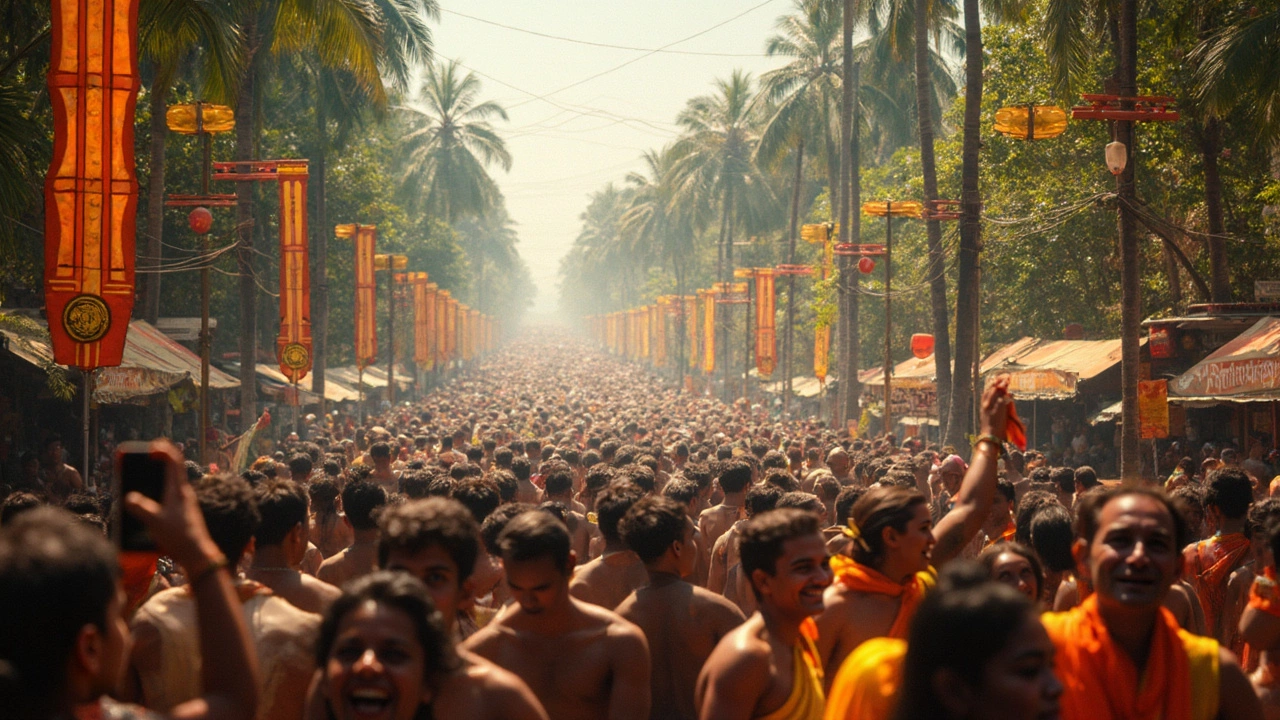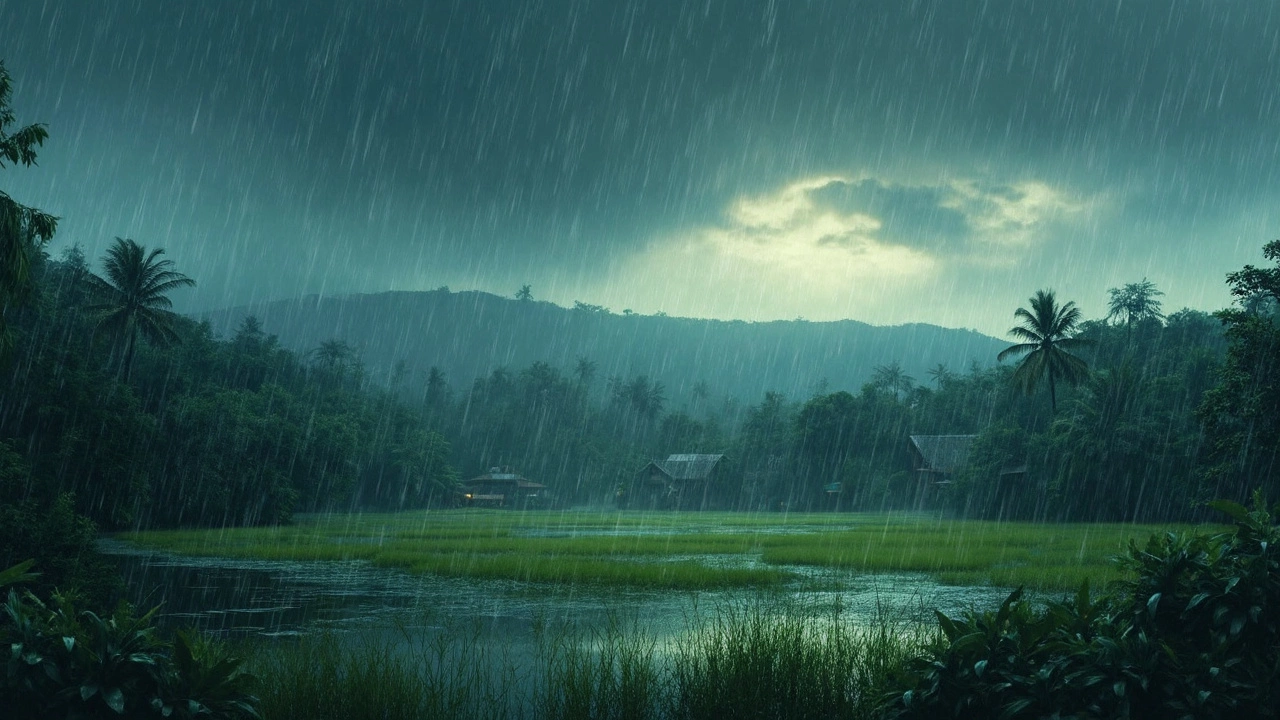When to Avoid Visiting Kerala: Timing Your Trip to South India
 Feb, 15 2025
Feb, 15 2025
So, when shouldn't you visit Kerala? Let's face it: while Kerala is a dreamy place for many, there are moments when it might not live up to your ideal travel expectations. First and foremost, keep an eye on the monsoon season. From June to September, the heavy rains can cause flooding, disrupt travel plans, and leave you stuck indoors when you'd rather be exploring the backwaters.
Then there's the Kerala summer, stretching from March to May, which might surprise you with its intense heat and humidity. Unless you're a fan of high temperatures, this time of year might not be for you.
And don't forget the festival season! While festivals like Onam in late August or September can be culturally enriching, they also bring in crowds that might overwhelm the peaceful vibe you were hoping for.
- Monsoon Madness
- Summer Scorchers
- Festival Frenzy
- Crowds and Chaos
- Off-Peak Perks
- Alternative Travel Tips
Monsoon Madness
Ah, the Kerala monsoon. It's a love-hate relationship for many travelers. The monsoon season, running from June to September, can be both a blessing and a curse. If you're into lush greenery and dramatic landscapes, you'll find Kerala at this time breathtaking. However, for those who prefer sunny, dry days for sightseeing, this period might throw more rain your way than you'd like.
Rain, Rain, Go Away
The monsoon deluge can lead to roadblocks and landslides, especially in the hilly areas like Munnar. Some places become inaccessible due to poor road conditions or flooding. So, if sightseeing is your goal, you might want to avoid risking a wet and risky trip during these months.
Travel Disruptions
Monsoon also means potential delays and cancellations with transportation. Whether it's train schedules being thrown off or flights delayed, be prepared for disruptions that can cut into your travel plans. It's advisable to check weather updates and have backup plans if you're transiting through Kerala at this time.
Let’s be honest—it can get frustrating.
Stats Speak
If you're into numbers, here's a quick look at average rainfall:
| Month | Rainfall (mm) |
|---|---|
| June | 680 |
| July | 810 |
| August | 780 |
As you can see, it's quite a bit of rain. Now, some folks might enjoy the cozy indoors or a wet adventure, but if you're not one of them, think twice before booking a ticket for the monsoon season.
What to Do If You Must Go
- Stay in bigger cities like Kochi or Thiruvananthapuram that have better drainage systems to handle the rain.
- Make sure your travel insurance covers weather-related cancellations.
- Carry waterproof gear and always have a backup plan for indoor activities.
Ultimately, weighing the thrill of experiencing Kerala during the monsoon against potential inconveniences can help you decide if it’s worth the trip.
Summer Scorchers
So you're thinking about heading to Kerala in the summer? Hold up! The summer months, specifically March through May, can get pretty intense here. With temperatures often soaring above 35°C (95°F), it's not just a walk in the park. The humidity levels can make it feel even hotter, turning any casual stroll into a real workout.
A major reason folks might want to think twice about visiting during this time is the blazing heat that can knock you for a loop. The coastal regions might give you some relief with cooler sea breezes in the evenings, but if you're planning on exploring inland or hitting the hill stations, the heat can still be a beast.
Beaches and Backwaters
While the beaches are quieter during summer and you might find some solace in the calm backwaters, the scorching sun can seriously put a damper on water activities or leisurely boat tours. It's essential to slather on the sunscreen, keep hydrated, and wear hats or scarves to shield yourself from the heat.
Beating the Heat
- Seek shade between 11 AM and 3 PM when the sun is at its peak.
- Carry a reusable water bottle to stay hydrated.
- Choose lightweight, breathable clothing to stay cool.
If you're determined to travel during this period, consider staying in accommodations with air conditioning and proximity to indoor attractions like museums or cultural centers, where you can escape from the sweltering heat, even for a short while.
While the summer might not be the easiest time to visit, there are perks like lower accommodation rates and fewer tourists. But weigh that against the downsides of a Kerala travel experience marked by relentless sunshine and humid days.
Festival Frenzy
Ever wonder what Kerala's like during festival season? It's vibrant and full of energy, but it can also mean huge crowds and challenging travel conditions. If you're drawn to cultural experiences, these times can be magical, though they may not be for everyone's taste.
The Big Ones: Onam and Theyyam
Onam is one of the biggest festivals in Kerala, usually celebrated between August and September. It's a ten-day long affair, where the entire state comes alive with colorful parades, traditional dances, and feasting. However, this also translates to crowded tourist spots and busy streets.
Theyyam performances, taking place from October through May, are a visual treat. This ritualistic art form involves elaborate costumes and face painting, creating captivating scenes of devotion. But being a popular event, expect high interest and packed venues.
Understanding Local Culture
Joining in can deepen your understanding of Kerala's rich heritage. However, be prepared for lines at major attractions, packed hotels, and possibly escalated prices due to demand. Urban centers like Kochi and Thiruvananthapuram can get quite hectic.
Should You Avoid It?
If you're more into peace and quiet, it might be best to steer clear during these celebrations. Still, for the flexible traveler, experiencing Kerala in full festival mode could be a unique adventure worth any logistical headaches.

Crowds and Chaos
Imagine this: you've planned a serene getaway to the stunning beaches of Kerala, but you're greeted by swarms of tourists at every corner. Certain times of the year, Kerala’s natural beauty is somewhat overshadowed by an influx of visitors. Let’s break down when and why this happens.
One major period to consider is the peak tourist season, which runs from November to February. This season coincides with cooler, more pleasant weather, attracting travelers from around the globe eager to escape the winters in other parts of the world. While this is a comfortable time weather-wise, it’s also when you'll face potentially long queues at popular attractions like the Periyar Wildlife Sanctuary and the famous Munnar tea gardens.
Local Festivals
Another factor contributing to the crowd surge are local festivals, such as Onam and Vishu. While these are wonderful cultural experiences, they draw huge numbers of domestic tourists. Popular spots like Kochi and Thiruvananthapuram can be particularly packed, making it difficult to fully appreciate the cultural sites, like the Mattancherry Palace, without a crowd.
Tips to Avoid the Rush
- If you must visit during a busy time, book your accommodations well in advance to avoid skyrocketing prices and limited options.
- Explore lesser-known but equally stunning destinations off the beaten path, like Wayanad or Kannur, which tend to remain quieter.
- Consider visiting tourist hotspots early in the morning to dodge the afternoon masses.
Being mindful of these high-traffic periods can help ensure a more peaceful and enjoyable Kerala experience, without the hassle of constant chaos and overcrowding.
Off-Peak Perks
Visiting Kerala during the off-peak season can be a game-changer for your travel plans. While it might not seem ideal to venture in less popular months, there are several advantages you might not have considered. If you avoid the Kerala travel rush, you'll likely have a more relaxed and budget-friendly trip.
First up, lower costs! During the off-peak months of April to May and September to November, hotel rates drop significantly. This is your chance to snag better deals on accommodation and even flights. Many resorts offer attractive discounts, allowing you to experience luxury without breaking the bank.
South India is known for its greenery, and visiting during these times can highlight lush landscapes, thanks to recent monsoon rains. You'll find cleaner roads and fresher air without the hustle of tourist crowds. Plus, with fewer people around, you can have a more intimate experience with nature—perfect for those looking to escape overcrowded spots.
Moving on to activities, this period can be an excellent chance to enjoy a quiet backwater boat ride or peaceful trekking in the Western Ghats. You’re more likely to engage with locals, who are generally less stressed when the tourist season calms down. This can lead to more authentic cultural experiences and interactions.
Need more convincing? Check out this quick comparison:
| Season | Hotel Rates | Crowd Levels | Weather |
|---|---|---|---|
| Peak | High | Dense | Mild |
| Off-Peak | Low | Sparse | Warm |
This table highlights just a few perks that off-peak travel brings. So next time you're planning your Kerala travel, consider these advantages, and you might just find that the quiet months offer everything you need for a memorable trip.
Alternative Travel Tips
Looking for ways to enjoy Kerala travel without getting caught up in the hustle and bustle? Here are some cool alternatives that can make your trip to south India more relaxing and unique!
Off-Peak Marvels
Traveling off-peak doesn't mean missing out. In fact, visiting Kerala in October or February can offer pleasant weather and fewer tourists. Imagine strolling through the tea plantations of Munnar without bumping into crowds.
Local Hideaways
Skip the usual spots and seek out lesser-known destinations. Ever heard of Wayanad? It's a gem waiting to be explored, with lush hills and cascading waterfalls. Or try Valiyaparamba, a serene backwater destination that's as beautiful as the popular Alleppey, but way more peaceful.
Embrace Public Transport
Consider using Kerala's extensive public transport network. Hop on a local bus or take the train for a real authentic experience. Not only does it save money, but it also lets you mingle with locals and learn about their culture firsthand.
Travel Smart with Events
Check the calendar for regional events that could spark your interest or those you’d rather avoid. For instance, the Cochin Carnival in December brings excitement to Fort Kochi with its vibrant parades and fireworks, but it also means more crowds.
Flexible Plans
Don’t be afraid to keep your itinerary loose. Kerala's charm often lies in its spontaneous discoveries, like stumbling on a local seafood festival or an impromptu “kathakali” (dance-drama) performance. Allow room for these surprises!
Whether you’re visiting for the second or fiftieth time, these tips can help you experience Kerala in a different light, ensuring that your trip is both enjoyable and unforgettable.